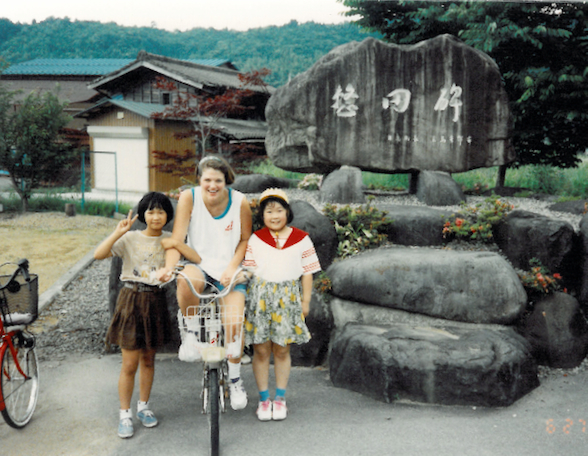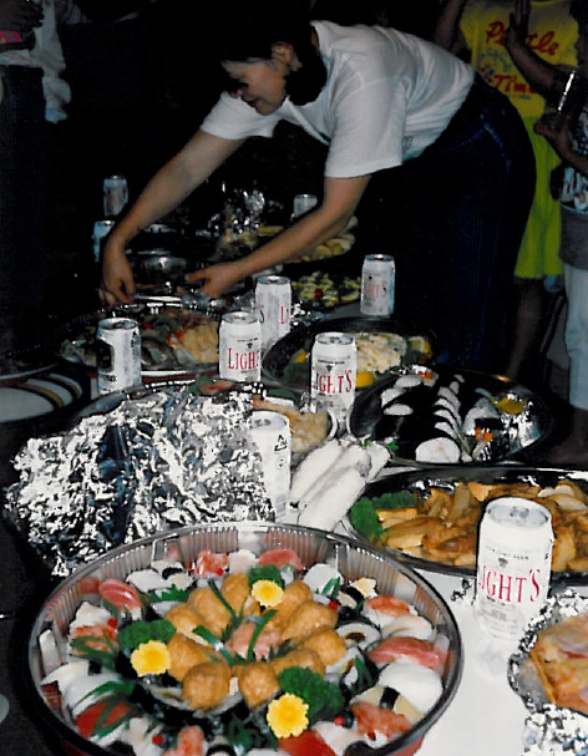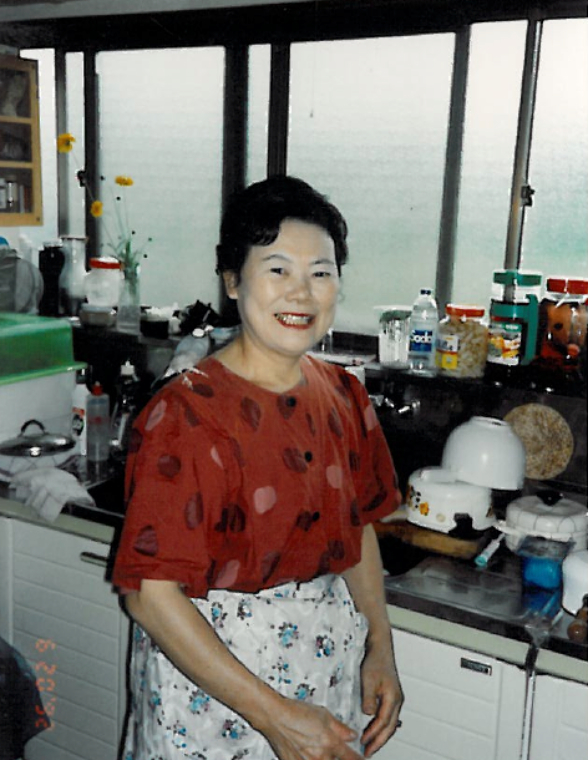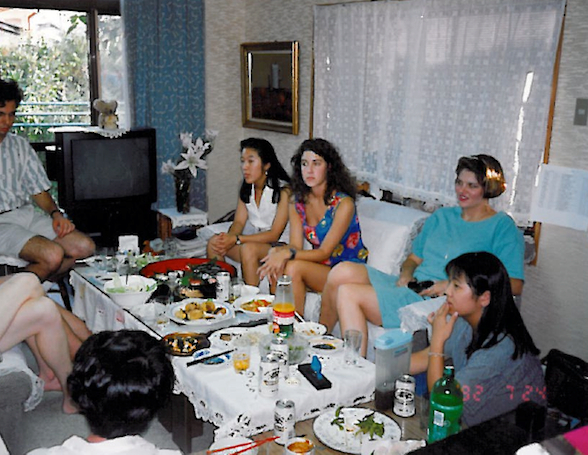In search of America-shoku

Living in Shirotori, Japan was the equivalent of living in rural Appalachia. Here I am at age 20 on the only transportation I had aside from my own two feet. Enamored and fascinated by the countryside, I ran long distances so that I could see, smell and hear even more of this place. I ran so much that, by the time I got home that fall, I had unintentionally trained enough to run my first marathon. So I did.
I traded in tagines for dashi this winter. I’ve been having a two-year long affair with the food of Morocco. I still love it, but Japanese cooking has me under its spell of late. I guess it is- in part- about contrast. I joke with Bill that- should he meet with an untimely demise or just really piss me off- my next love would probably be a cowboy or logger or something. I mean, I’ve had a banker already. I’d want something new. Right? This is surely the origin of my crush on Mike Rowe (Dirty Jobs).
I actually speak Japanese, spent most of my pre-kids career working for Japanese companies and have travelled extensively throughout Japan. Though I never was able to accept dried fish, rice, miso soup and pickled radishes for breakfast, in general, I’ve always loved Japanese food. For some reason, I’ve never had the impulse to cook it until recently. I think there was some sort of intimidation factor relating to the ingredients or something.

One of the many feasts served to us during my time in Japan. Large platters of sushi were the Japanese equivalent of the Costco deli tray.
Among the small library of books on Japanese cookery I’ve acquired in the past few weeks is a book called “Washoku” by American-born Elizabeth Andoh. I woke up at 5AM last Thursday and- unable to get back to sleep- decided to steal some quiet that morning. I brewed some coffee, lit some candles, and began to read the Introduction of Washoku. Yes, I read cookbooks the way that other people might read chick-lit. Its my guilty pleasure.
Washoku is the Japanese word for “traditional cuisine.” It describes most of the food I ate most of the time when I lived in Japan and what I usually ate when dining out in New York City with my former employers. It is separate and distinct from yoshoku, or foreign food. When staying at any hotel or inn in Japan at any price point, you will always be asked whether or not you would like to have a yoshoku or washoku breakfast prepared for you in the morning. Yeah, you guessed it. I’m a yoshoku eater before 10AM
Elizabeth’s description of the principles of washoku completely blew me away that morning. I spent the entire day mentally digesting what I’d read. Though this is a bit of a long excerpt, I could not possibly summarize what she wrote any more concisely than the way that she wrote it.
The philosophy and practice of washoku can best be summarized by a set of five principles that describe how to achieve nutritional balance and aesthetic harmony at mealtime. The first three principles- one each concerning color, flavor palate, and choice of cooking method- – deal with the practical considerations of food preparation. The fourth principle defines the sensual nature of food- that is, the need for food to appeal to all of the five senses, not just taste and smell. The final principle, which is more spiritual and philosophic, compels us to appreciate both human endeavor and the natural forces that provide for us.
The five principles of washoku are as follows:
- Five colors, or go shiki, suggests that every meal include foods that are red, yellow, green, black and white. (Often very dark colors, particularly deep purple- eggplant, grapes- and sometimes brown- shiitake mushrooms- are counted as black.) Vitamins and minerals naturally come into balance with a colorful range of foods.
- Five tastes, or go mi, describes what the Japanese call anbai, a harmonious balance of flavors- salty, sour, sweet, bitter, and spicy- that ensures our palates are pleasantly stimulated, but not overwhelmed.
- Five ways, or go hoo, urges cooks to prepare food by a variety of methods, simmering, broiling, and steaming being some of the most basic. By combining various methods at every meal, it is easy to limit the total amount of sugar, salt and oil consumed, thereby avoiding excessive calories.
- Five senses, or go kan, advises cooks to be mindful not only of taste, but also of sight, sound, smell, and touch (in this case, the texture of food as we eat it).
- Five outlooks, or go kan mon, are rules concerned with the partaking of food and have a strong basis in Buddhism. Indeed, many Buddhist temples in Japan that serve vegetarian fare (shoojin ryoori) will have these rules written on their menus. They instruct us, first, to respect the efforts of all those who contributed their toil to cultivating and preparing our food; second, to do good deeds worthy of receiving such nourishment; third, to come to the table without ire; fourth, to eat for spiritual as well as temporal well-being; and fifth, to be serious in our struggle to attain enlightenment.
…A vocabulary emerged to describe various aspects of this distinctive Japanese food culture. Kisetsukan is what the Japanese call their keen appreciation for seasonal cycles and other rhythms of nature. The word shun is used to describe a point in time when a particular food is at its peak of flavor. Shun can last for several weeks or even months- or it can be as fleeting as a few hours or days. The notion of meisanbutsu, or “regional specialties,” holds locally produced foodstuffs in especially high regard. In Japan, where lakes, rivers, and the ocean provide abundant food to complement the harvest of the land, the phrase umi no sachi, yama no sachi (the bounty of the sea, the bounty of the mountains) describes the harmonious union of foods from both land and water sources.
…Most Japanese today would have a hard time articulating washoku notions, and would not usually discuss among themselves the guidelines for assembling a nutritionally balanced, aesthetically pleasing meal. Yet when choosing items from an a la carte restaurant menu, selecting prepared dishes to take home from a department store food hall, or purchasing packaged food from a convenience store or supermarket, most Japanese will, by instinct, employ the five principles on some level to create culinary harmony.

Okaasan is the Japanese word for "mother." It is a term that conveys affection for any woman who blesses you with her care- or cooking. This is a picture of "my" Shirotori okaasan in her kitchen. That kitchen was so very tiny. She served three meals a day from that kitchen- each one prepared with thought, joy and love.
Washoku is what we are yearning for here in America. We are looking to science, ethics, religion and economics for some idea of what it means to have a nourishing food culture. Many of the ideas that have been put forth by the leading thinkers in cooking, nutrition and agriculture mirror the washoku ideas so closely that it is a bit eerie. These ideas have been accepted wisdom for millennia in Asian cultures, as well as in similar articulations in many other cultures. We seem to think they’re new discoveries.
Washoku offers balance to the oft-extremist locavores, vegans, vegetarians and nutritionists. It’s a culinary compass offered by the wisdom of history, tradition and culture. So often here in America, we are tossed about by the winds of food trends driven by individuals- with their inevitable biases, anxieties and fallible interpretations.
Americans don’t have much of a unified food culture. Even as I write that, I am convicted that it isn’t totally true. It is just that our food culture isn’t defined by what is good or right or pure. It is rather defined by a single carnal impulse: appetite.

A washoku spread made with great care at the home of the Sugimotos, friends of my father in Kyoto. I'll never forget the flavor of these really simple noodles served cold with minced fresh shiso leaf. The sushi was all handmade.
I want a simple, time-tested way to eat that is balanced and liveable. I want that to be something that is internalized in my children. I don’t want them to have to read food labels or count calories. I want them to just have a sense of what is right and wrong when they eat. I want their foodlives to embody the values of moderation, balance and gratitude. I want that to be their “common sense.”
I’ve been playing with integrating the virtues of washoku in my foodlife already. It strikes me that these principles can be just as easily applied to Western cuisine as Eastern. I think I’m onto something.
Next time I find myself with another group of whack-a-doodle foodies advocating everything from locavorism to flexatarianism, I think I’ll just proclaim that I eat according to washoku eating principles. Won’t I sound so interesting, well-travelled, and enlightened? Think I can start a trend?
Question: If okaasan asked you what a good family meal looks like in the States, what would your answer be?



